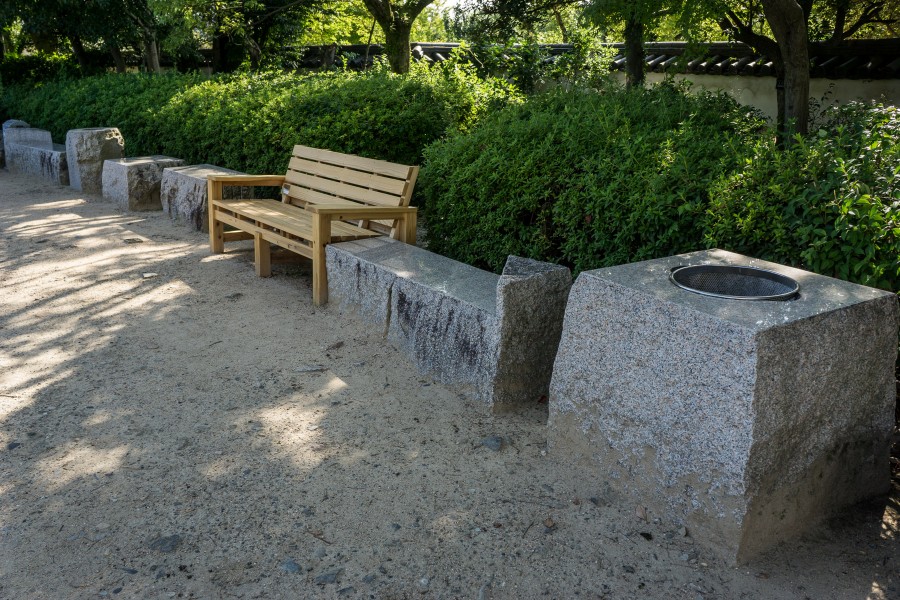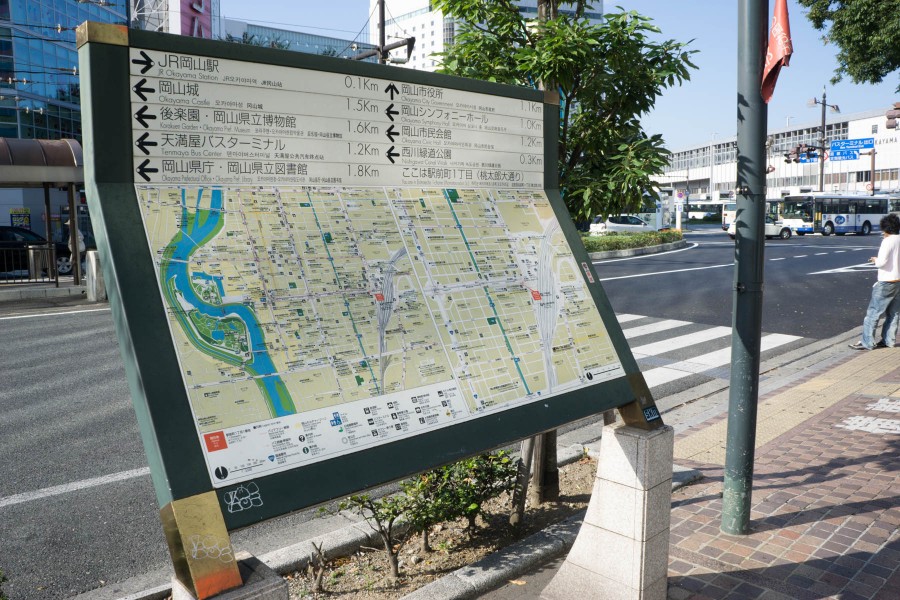Japan, as many perceive, is a land of meticulous attention to detail, whether it is personal interaction or a built construct in the landscape. So if, upon visiting there, one were to happen upon some inconsistencies with that vision, what would that say about Japan?
From September 26, 2014 until October 7, 2014, I had the opportunity to travel about West Japan, which I will write about in detail here in the coming weeks. However, I can say with certainty that there were several experiences, either one-off or continual, that I found rather jarring for a society that models itself on common sense, proper decorum and civility towards social needs:

Intentionally designed site furniture at Okayama Castle.
1. There are outdoor vending machines literally every 200 meters, but then, where are the litter bins to throw your used bottles out? It is remarkably clean in Japan, and I had known there is a high amount of self-discipline to clean after oneself in Japan, but I would think that in a city environment this would extend to placing litter bins (waste bins, trash receptacles, etc) in easily accessible areas in accordance to international standards. However, there were very often none to be seen! Their placement in tourist areas was very limited and, for example in Osaka, none could be found on in the Osaka Castle Park (I had throw my trash away inside of the Castle). In China and India, if there aren't any litter bins, people just throw their trash away where it's convenient, which in many cases lead to disastrous results.
2. In the public realm there is the social expectation to sit down and enjoy the view (or to sit down and take a rest). To that end, why are there so few benches in the landscape? In malls, there are none to be seen, perhaps acting as physical deterrents to loitering. In parks, there are a few and often only heavily concentrated in one area (and hence, quite often, filled to capacity). So it is not that the Japanese don't sit -- but that someone has decided that they should sit only in a few areas?

This street map in Okayama is "upside down"
3. Japan is notorious for making it difficult to get around. If you have an address you can count on getting the Post Office getting something delivered to it, but good luck trying to find the address on your own. So modern conveniences such as Google Maps make traveling around Japan a powerful asset. That being said, Japan does make an effort to provide large maps and wayfinding posts around a city, but why do they almost never point maps north up? Really, if anyone in the past 20 years has had any exposure to maps on the internet, and, also maps on paper for the past +100 years (older maps may point south upwards), most would see that north is almost always upwards. So I was often momentarily confused looking at the map as I did not recognize the terrain until I realized that the North arrow was pointed in a different direction. I understand their logic for doing this; it does, in a way, make navigation easier, but, if you're not familiar with a place, it does not help.
4. I don't understand the logic of providing vending machines filled with liquid beverages and not provide vending machines with instant meals? Once I had seen a vending machine for ice cream and once in a hotel there was a vending machine selling instant noodles, so it is not as if the capability for providing this does not exist. Very often in Japan restaurants seem to follow "banker hours" as well as "museum hours". That is, in smaller cities and villages they will close earlier on the weekend, or not at all on both Sundays and Mondays, and occasionally will not be open when you might expect. So if vending machines provided instant meals, it could help alleviate instances of missing the "window of opportunity" of eating dinner after a day of sightseeing. Convenience stores such as Lawson, Family Mart or 7-Eleven provide packaged meals but they are not many of them in smaller cities.
5. I had heard that Japan has a very-well connected (to the internet) population but fast connection speeds or even WiFi was not ubiquitous. I rented something called a WiFi box, which enabled me to use a device that provided a WiFi hotspot via an embedded 4G mobile card (more convenient than using a 4G SIM card in your phone as you don't need to worry about if your phone is compatible with the GSM frequencies; and it also extends your phone's battery life as you can use airplane mode and use the phone on WiFi only). In the big cities the connection ranged from good to poor, and in smaller cities and villages I was lucky to get something akin to 2G. Free WiFi was sometimes provided in railway stations, but only for anywhere from 20 minutes to 3 hours. So the internet experience was somewhat disappointing and a little aggravating when depending on Google Maps to know where I was sometimes. I often felt that, despite the censorship, the internet is faster in China. But then, it was easy to ask people for directions if I got lost (I was never turned down; everyone felt that it was a matter of honor to help me). And, it was especially interesting to see electronic (LED) billboards used to "advertise" Typhoon warnings, such as the Typhoon that threatened to affect my travel plans while in Japan (as I have overzealously taken about 2,500 photographs while in Japan and it is necessary to develop the RAW images and add captions to all of them, I'm rather behind schedule with my images; so I will update this post later with a photo of this "Typhoon Advertisement" at a later date).
6. I had read that Japanese are rather xenophobic towards foreigners and expatriates, and my experience while traveling around Japan fitted that mold, quite unfortunately, rather well. In China this is often the complete opposite, as any foreigner in smaller and more remote places will be the center of attention (generally to be expected of visiting any developing country; this is true in South Asia as well as Africa). In Japan I was largely left alone, with middle school students the only people *adventurous* enough to approach me, and that I think, was only because they were required to by their teachers. Often there was groups of students hanging out at the train station (in Kyoto) as well as at the historic sites (in Nara) whose sole mission was to track down foreigners to practice their English. They had a whole set of prepared questions to ask. However, I was also expecting to have shop owners "run away" from seeing a foreigner enter their shop, as I had read that this is what they do when they see one and are unable to speak in English, but luckily I did not experience this. It would have been awkward anyway. Interestingly, everyone immediately spoke to me in Japanese first before trying to speak English, often with poor results; however, due to my veteran experience of reading body language in China I was usually able to understand the general meaning irregardless. So perhaps they could tell I was not a typical tourist; at the very least, I wasn't dressed like one.